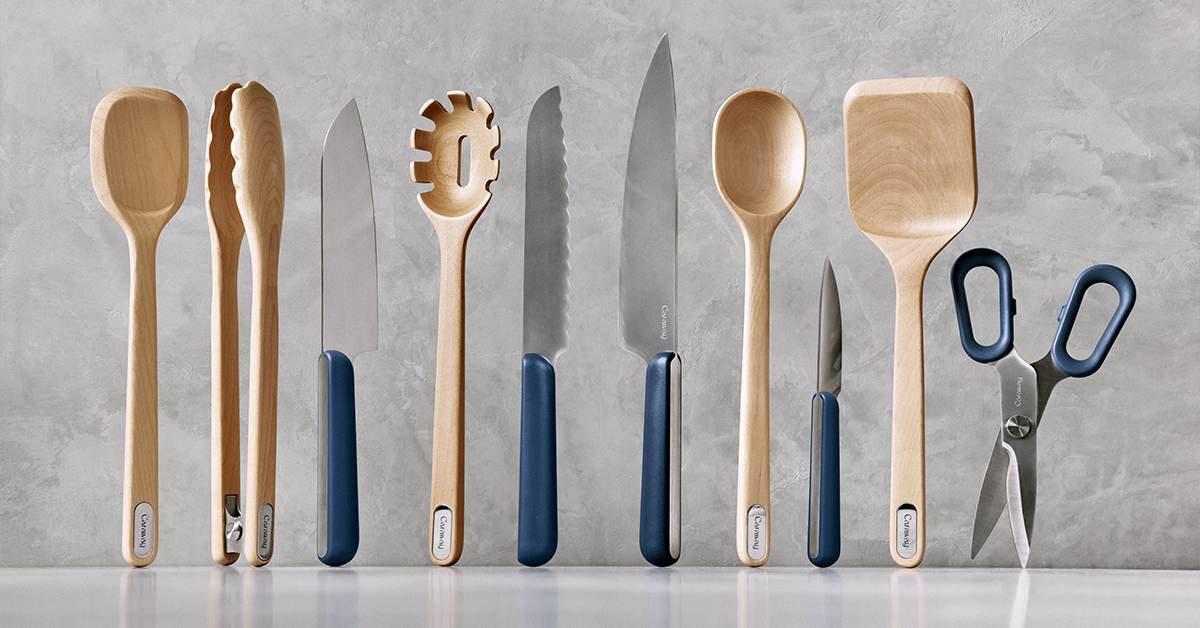You have no items in your cart
Shop our collectionsFree Shipping On Orders $90+
Free Returns
30-Day Trial
Home & Kitchen with Caraway

Microplastics are everywhere—in the water we drink, the food we eat, and even in the air we breathe. The kitchen, where so much of our daily lives revolve, can be a surprising source of these tiny plastic particles.
At Caraway , we believe your cooking space should be as safe as it is functional and free from contaminants like microplastics that can compromise your health. Reducing exposure to these harmful materials doesn’t have to feel overwhelming. With a few smart swaps and better habits, you can create a kitchen that supports your health and sustainability goals.
Let’s break down where microplastics might be sneaking into your routine and how to kick them out for good.
Microplastics are tiny plastic particles, often smaller than 5 millimeters , that come from the breakdown of larger plastic items like single-use plastics, plastic packaging, and even textiles. Microplastics can also be intentionally manufactured, like microbeads used in certain products.
In the kitchen, they’re often a result of wear and tear on plastic containers, utensils, and other common items. They can also enter through tap water, food wrapped in plastic products, or even certain cooking methods. Microplastics have become so prevalent that they’re found nearly everywhere—including in places you wouldn’t expect, like tea bags and food containers.
Now that you know what microplastics are, you’re probably wondering how they might affect your health. While research is ongoing, there’s growing evidence that these tiny plastic particles can have some concerning effects when they make their way into your body.
Here’s what we know so far:
Microplastics can carry toxic chemicals that may upset the body’s natural balance. When they leach from things like plastic containers or single-use plastics, they can create subtle changes in how your body functions.
Some studies suggest that microplastics can trigger what’s known as oxidative stress —a situation where your cells work harder than they should to deal with harmful molecules. Over time, this added strain can lead to wear and tear on your body.
Chemicals found in plastics, like BPA, phthalates, and PFAS, are known to mess with hormones. They can mimic or block normal signals in your body, throwing off your endocrine system and potentially affecting your metabolism and growth.
So, what are the biggest culprits when it comes to microplastics in your kitchen? While some exposure might seem unavoidable, there are a few key areas where microplastics tend to show up more often.
Those convenient wraps and containers often used for storing food are a major source of microplastic pollution. Over time, the plastic particles in packaging can break down and contaminate the food they’re meant to protect. Opting for alternatives like plastic-free wraps or reusable bags can help cut down on your exposure.
Everyday plastic items like food storage containers, spatulas, and utensils can release microplastic particles—especially when exposed to heat or heavy use. Repeated microwaving or washing in the dishwasher can speed up this process, making stainless steel, glass , or wooden utensils a safer choice.

Surprisingly, tap water can be a hidden source of microplastics. A new study found that water systems in many parts of the world, including America, can contain tiny plastic particles . Installing a water filter system is a simple way to reduce contaminants in your drinking and cooking water.
Cooking at high temperatures with plastics—like steaming vegetables in a plastic container—can release toxic chemicals and plastic particles into your food. To avoid this, use alternatives like stainless steel cookware , glass food containers, or enameled cast iron skillets for heat-intensive tasks.
Reducing microplastic exposure in the kitchen doesn’t require an overhaul of your routine—just a few smart swaps and mindful habits. By choosing safer materials and rethinking how you store, cook, and serve food, you can significantly cut down on plastic particles in your meals.
Here’s where to start:
Say goodbye to plastic containers that break down over time, especially when exposed to heat or acidic foods. Switching to stainless steel or our Glass Food Containers provides a safe, durable alternative that won’t leach toxic chemicals into your food. Plus, they’re reusable and eco-friendly, aligning perfectly with a more sustainable lifestyle.

Plastic utensils can degrade with heavy use, releasing microplastic particles into your food. Instead, choose tools made from natural materials like wood or stainless steel. Our Wooden Utensils are gentle on cookware, while metal options, like tongs and ladles, are durable and heat-resistant, making them great for daily use.
Avoid cookware with non-stick coatings that often contain PFAS or other toxic chemicals. Instead, opt for cast iron skillets or Caraway’s Stainless Steel Cookware , which are long-lasting, versatile, and completely safe at high temperatures. These materials don’t break down over time, offering a reliable way to cook without worrying about plastic particles.

Microwaving or reheating food in plastic items is a surefire way to release microplastic particles into your meals, especially at high temperatures. Use glass containers or heat-resistant materials like ceramic instead. It’s an easy swap that makes a big difference in reducing contaminants.
Single-use plastic water bottles and straws are major contributors to plastic waste and microplastic pollution. Opt for reusable options made from materials like stainless steel or glass. They’re better for the planet than bottled water and help you avoid exposure to chemicals like phthalates and BPA.
Even tap water can be a significant source of microplastics. Installing a water filter system can reduce contaminants like plastic particles, PFAS, and other potential toxins in your cooking and drinking water. Look for filters certified to remove microplastics and harmful chemicals to ensure your water is as clean as possible.
Switching to natural fibers for kitchen textiles like towels, cleaning cloths, and napkins helps cut down on the release of synthetic fibers into the environment. Materials like cotton or linen are not only safer but also biodegradable, making them a smart choice for those aiming to live more sustainably.
Pre-packaged fruits and vegetables often come wrapped in plastic packaging, increasing your exposure to plastic particles. Choosing fresh and unpackaged produce supports a plastic-free kitchen and helps reduce overall plastic pollution. Bonus points if you shop locally to cut down on plastic waste from transportation and storage.
Seafood is one of the most common food sources for microplastic pollution , as fish and shellfish can ingest plastic particles in their environment. While seafood can be nutritious, it’s worth limiting consumption or sourcing from sustainable fisheries that work to minimize plastic contamination.
Many tea bags are made with plastic materials that can release microplastic particles into your drink when steeped in hot water. Switching to loose-leaf tea eliminates this health risk and is often a more flavorful, high-quality option. Pair it with a stainless steel strainer for an easy, plastic-free brew.
Keeping microplastics out of the kitchen is an important step, but reducing your exposure in daily life can make an even bigger impact on your health and the environment. Small changes add up, from the products you buy to how you use them.
Consider these tips to minimize microplastic exposure beyond the kitchen:
Rethink Household Cleaning Products: Many sponges, scrubbers, and cleaning wipes are made from synthetic fibers that shed microplastics during use. Switch to natural alternatives like plant-based scrubbers or cotton cloths.
Use an Air Purifier: Indoor air can carry microplastic particles, especially in homes with synthetic furniture or carpets. An air purifier designed to capture fine particles can help reduce airborne contaminants.
Swap Plastic Toys for Safer Materials: If you have kids, opt for wooden or silicone toys instead of plastic products, which can degrade over time and release tiny plastic particles.
Choose Paper Over Plastic: Items like notebooks, office supplies, and gift wraps are often coated in plastic. Opt for plastic-free or recycled paper alternatives.
Upgrade Personal Hygiene Items: Toothbrushes, razors, and even menstrual products can contain plastics. Look for biodegradable or reusable options made from natural materials to minimize waste and plastic pollution.
These simple yet impactful changes help create a healthier, more sustainable lifestyle while keeping harmful plastic particles at bay.
Reducing microplastic exposure is no longer just an environmental concern—it’s about protecting your health and making smarter, more sustainable choices. From rethinking the materials in your kitchen to adjusting everyday habits, every small step adds up to a cleaner, safer lifestyle.
At Caraway , we’re proud to offer cookware that aligns with these goals. Our ceramic non-stick cookware is free of forever chemicals like PFAS, PFOA, and PTFE, providing a safer, eco-friendly alternative to traditional options.
Designed for real-life use, it combines performance with peace of mind, making your kitchen healthier and more functional. Ready to make a change?
Explore our thoughtfully crafted products and take the first step toward a non-toxic, microplastic-free kitchen today. Cooking safely has never looked—or felt—better.
Sources:
What are microplastics and why are they a problem? | ClientEarth
Microplastics Everywhere | Harvard Medicine Magazine
Microplastics and Oxidative Stress—Current Problems and Prospects | PMC
Microplastics in Seafood and the Implications for Human Health | PMC
Add to cart to unlock a free gift!
Receive a Caraway X MATE Sweatshirt with orders $675+
Free Shipping On Orders $90+
Free Returns
30-Day Trial
Add to cart to unlock a free gift!
Caraway & MATE Sweatshirt
Spend $675
Add to cart to unlock a free gift!
Exclusive gift with orders $675+
Caraway & MATE Sweatshirt